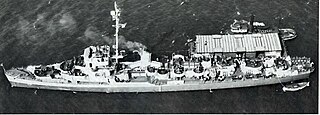
USS Kephart (DE-207/APD-61) was a Buckley-class destroyer escort in service with the United States Navy from 1944 to 1947. After spending 20 years in reserve, she was transferred to Republic of Korea Navy and served another 18 years as Kyong Puk (PF-82) until she was struck in 1985.

USS Humphreys (DD-236/APD-12) was a Clemson-class destroyer in the United States Navy during World War II. She was named for Joshua Humphreys, a pioneer US shipbuilder.

USS Schmitt (DE-676) was a Buckley-class destroyer escort in the United States Navy, commissioned in 1943. In late 1944, she was converted to a high speed transport and was redesignated APD-76. She was retired in 1949 and transferred to the Republic of China Navy in 1969, where she served as ROCS Lung Shan (PF-44) until 1976, when she was scrapped.

The USS Weiss (APD-135/LPR-135) was a Crosley-class high speed transport in service with the United States Navy from 1945 to 1970, with two short periods spent in reserve. She was finally scrapped in 1976.

USS Gantner (DE-60/APD-42), a Buckley-class destroyer escort of the United States Navy, was named in honor of Boatswain's Mate Samuel Merritt Gantner (1919-1941), who was killed in action during the Japanese attack on the Hawaiian Islands.

USS Ira Jeffery (DE-63/APD-44), a Buckley-class destroyer escort of the United States Navy, was named in honor of Ensign Ira Weil Jeffery (1918–1941) who was killed in action during the Japanese attack on the Hawaiian Islands while serving aboard the battleship California.

USS Amesbury (DE-66/APD-46), a Buckley-class destroyer escort of the United States Navy, was named in honor of Lieutenant (jg) Stanton Morgan Amesbury (1916–1942), who was killed in action while flying from the aircraft carrier Ranger (CV-4) during Operation Torch in 1942.

USS Hopping (DE-155) was a Buckley-class destroyer escort in service with the United States Navy from 1943 to 1947. In 1944, she was converted to a Charles Lawrence-class high speed transport and redesignated "APD-51". She was sold for scrap in 1966.

USS Reeves (DE-156/APD-52) was a Buckley-class destroyer escort in service with the United States Navy from 1943 to 1946. She was transferred to Ecuador for use as an electric generator plant in 1960. Her final fate is unknown.

USS Loy (DE-160/APD-56), a Buckley-class destroyer escort in service with the United States Navy from 1943 to 1947. She was converted to high-speed transport (APD) in late 1945. Following her decommissioning, she spent another 19 years in reserve before being sold for scrap in 1966.

USS Lloyd (DE-209/APD-63), a Buckley-class destroyer escort of the United States Navy, was named in honor of Ensign William R. Lloyd (1916–1942).

USS Burke (DE-215/APD-65), a Buckley-class destroyer escort of the United States Navy, was named in honor of Lieutenant Commander John E. Burke (1905–1942), who was killed in action, aboard the battleship South Dakota during the Naval Battle of Guadalcanal on 15 November 1942.

USS Bowers (DE-637/APD-40), a Buckley class destroyer escort of the United States Navy, was named in honor of Ensign Robert K. Bowers (1915-1941), who was killed in action aboard the battleship USS California during the Japanese attack on Pearl Harbor on 7 December 1941.

USS Laning (DE-159/APD-55) was a Buckley-class destroyer escort in service with the United States Navy from 1943 to 1946 and from 1951 to 1957. She was scrapped in 1975.

USS Howard D. Crow (DE-252) was an Edsall-class destroyer escort built for the U.S. Navy during World War II. She served in the Atlantic Ocean the Pacific Ocean and provided destroyer escort protection against submarine and air attack for Navy vessels and convoys.

USS Brock (APD-93), ex-DE-234, was a United States Navy high-speed transport in commission from 1945 to 1947.

USS John Q. Roberts (APD-94), ex-DE-235, was a United States Navy high-speed transport in commission from 1945 to 1946.
USS Hunter Marshall (APD-112), ex-DE-602, was a United States Navy high-speed transport in commission from 1945 to 1946.

USS Bassett (APD-73), ex-DE-672, was a United States Navy high-speed transport in commission from 1945 to 1946 and from 1950 to 1957.

USS Jack C. Robinson (APD-72), ex-DE-671, was a United States Navy high-speed transport in commission from 1945 to 1946.



















